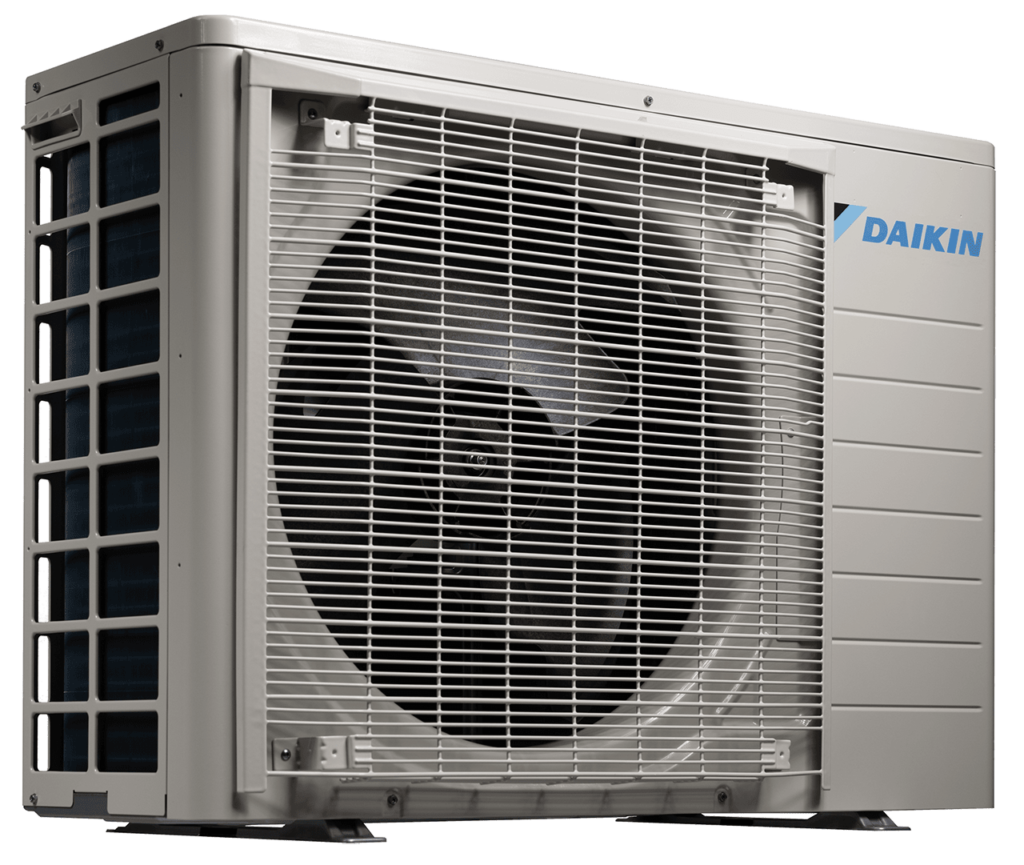
In Québec, summer can be just as demanding as winter. While harsh winters are a given, periods of summer heat and humidity are sometimes underestimated. Yet, when the temperature rises above 30 °C and the humidex climbs beyond 35 °C, indoor comfort quickly becomes a challenge. A well-chosen air conditioner does more than cool the air: it regulates humidity, improves indoor air quality, and optimizes energy consumption.
In a hot and humid climate, an improperly sized or poorly installed unit can result in high energy bills, uneven comfort, and even health problems linked to excessive humidity (mold, dust mites, persistent odours).
Daikin, a global leader in air conditioning, designs systems specifically adapted to North American climate realities, combining high performance, durability, and advanced technology. This guide has been created to help you:
The wall-mounted air conditioner, or mini-split, consists of a compact outdoor unit and an indoor unit mounted on the wall. It operates without ducts, making it particularly appealing for existing homes without central ventilation. Inverter technology adjusts the power according to actual demand, reducing electricity use and providing constant comfort without abrupt temperature swings.
For more details, see our guide on the ideal placement of a wall-mounted air conditioner.
Polara: discreet design, advanced filtration, low noise, and high efficiency.
The central air conditioner is the ideal solution for houses equipped with ductwork. Its ability to cool all rooms evenly ensures consistent comfort, even in large or multi-storey homes. Thanks to its high airflow, it also provides better dehumidification capacity, which is essential during humid heat waves.
These systems, often invisible, are hidden in a false ceiling or technical closet. They preserve aesthetics while providing optimal comfort in multiple rooms. Their quiet operation is especially appreciated in environments where discretion is important.
Oterra: compact, quiet, energy-efficient, ideal for maximizing available space.
Type | Installation | Energy efficiency | Noise level | Filtration | Ideal for… |
Wall-mounted | Simple | Very high | Very low | Good to excellent | Targeted rooms, condos |
Central | More complex | High | Low | Excellent | Homes with ductwork |
Compact/Concealed | Moderate | High | Very low | Good to excellent | Small spaces, businesses |
The SEER (Seasonal Energy Efficiency Ratio) measures an air conditioner’s performance over an entire season. The higher the SEER, the more energy-efficient the unit. In Québec, aiming for a SEER of 18 or higher can significantly reduce summer bills. Each additional SEER point equals about 5% energy savings. A high-performance model, such as those featured in our guide on SEER and energy efficiency, can save hundreds of dollars over its lifetime.
Proper settings maximize comfort while minimizing consumption:
A smart thermostat makes these adjustments easier, as explained in our article on the ideal summer temperature.
Dry Mode is designed to reduce humidity without excessively lowering the temperature. It is especially useful on humid but moderately warm days. This setting helps maintain a comfortable humidity level (around 45%), prevents mould, and reduces odours. For more details, see our guide on optimal use of Dry Mode.
The Daikin One+ and One Lite thermostats offer advanced features:
Proper installation is crucial to ensure performance and durability. It begins with a heat load calculation, strategic placement, and electrical and refrigerant connections done to code. The orientation and height of the indoor unit directly affect airflow distribution. For more details, see our article on wall-mounted air conditioner placement.
Regular maintenance maintains performance and extends the unit’s lifespan:
Model | Type | SEER* | Key strengths | Ideal for… |
Polara | Wall | High | Discreet design, low noise, advanced filtration | Condos, specific rooms |
Daikin FIT | Central | 16–18 | Compact design, flexible installation | Homes with ductwork |
DZ4SE-DX3SQ | Central | High | Reliability and durability | Large homes |
Oterra | Compact | High | Quiet, space-saving | Studios, small businesses |
A 12,000 BTU unit typically suits rooms up to 50 m², while an 18,000 BTU covers about 75 m². Oversizing causes short cycles and less efficiency, while undersizing forces continuous operation.
Analyze the area to be cooled, insulation, sun exposure, and your habits. Compare SEER ratings, noise levels, and filtration quality. Choose reliable brands like Daikin and have it installed by a professional.
A quick rule: 9,000 BTU for ≤ 35 m², 12,000 BTU for 35–50 m², 18,000 BTU for 50–75 m², with adjustments for insulation and ceiling height.
Between 23 and 25 °C, with a nighttime reduction of 1–2 °C.
No, it complements cooling by removing moisture from the air.
Every 1 to 3 months, more often if the air is dusty or if pets are present.
Yes, they reduce unnecessary cycles and automatically adjust the temperature.
Choosing air conditioning adapted to the Québec climate means investing in lasting comfort, better air quality, and tangible energy savings. Daikin models (Polara, Daikin FIT, DZ4SE-DX3SQ, and Oterra) offer solutions for every configuration, from urban condos to multi-storey houses.
A well-informed choice relies on a precise evaluation of your needs, a comparison of performance, and partnership with a certified installer. With regular maintenance, your system will maintain its performance for over 15 years, ensuring comfort and peace of mind, summer after summer.


Nous utilisons des témoins (cookies) pour améliorer votre expérience de navigation, diffuser des publicités ou des contenus personnalisés et analyser notre trafic. En cliquant sur « Accepter », vous consentez à notre utilisation des cookies.